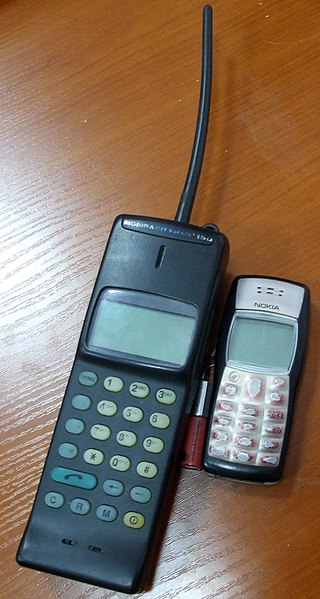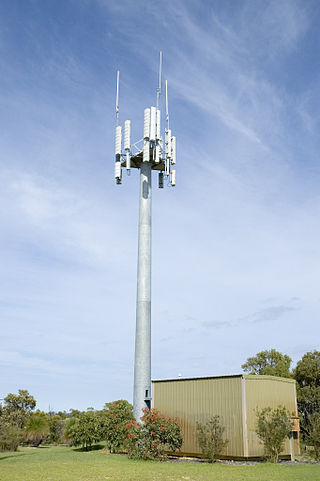Related Research Articles

Advanced Mobile Phone System (AMPS) was an analog mobile phone system standard originally developed by Bell Labs and later modified in a cooperative effort between Bell Labs and Motorola. It was officially introduced in the Americas on October 13, 1983, and was deployed in many other countries too, including Israel in 1986, Australia in 1987, Singapore in 1988, and Pakistan in 1990. It was the primary analog mobile phone system in North America through the 1980s and into the 2000s. As of February 18, 2008, carriers in the United States were no longer required to support AMPS and companies such as AT&T and Verizon Communications have discontinued this service permanently. AMPS was discontinued in Australia in September 2000, in Pakistan by October 2004, in Israel by January 2010, and Brazil by 2010.

3Gis the third generation of wireless mobile telecommunications technology. It is the upgrade over 2G, 2.5G, GPRS and 2.75G Enhanced Data Rates for GSM Evolution networks, offering faster data transfer, and better voice quality. This network was superseded by 4G, and later on by 5G. This network is based on a set of standards used for mobile devices and mobile telecommunications use services and networks that comply with the International Mobile Telecommunications-2000 (IMT-2000) specifications by the International Telecommunication Union. 3G finds application in wireless voice telephony, mobile Internet access, fixed wireless Internet access, video calls and mobile TV.
2G is a short notation for second-generation cellular network, a group of technology standards employed for cellular networks. 2G was commercially launched on the GSM standard in Finland by Radiolinja in 1991. After 2G was launched, the previous mobile wireless network systems were retroactively dubbed 1G. While radio signals on 1G networks are analog, radio signals on 2G networks are digital, though both systems use digital signaling to connect cellular radio towers to the rest of the mobile network system.

NMT is an automatic cellular phone system specified by Nordic telecommunications administrations (PTTs) and opened for service on 1 October 1981. NMT is based on analogue technology and two variants exist: NMT-450 and NMT-900. The numbers indicate the frequency bands used. NMT-900 was introduced in 1986 and carries more channels than the older NMT-450 network.
IS-54 and IS-136 are second-generation (2G) mobile phone systems, known as Digital AMPS (D-AMPS), and a further development of the North American 1G mobile system Advanced Mobile Phone System (AMPS). It was once prevalent throughout the Americas, particularly in the United States and Canada since the first commercial network was deployed in 1993. D-AMPS is considered end-of-life, and existing networks have mostly been replaced by GSM/GPRS or CDMA2000 technologies.

A cellular network or mobile network is a telecommunications network where the link to and from end nodes is wireless and the network is distributed over land areas called cells, each served by at least one fixed-location transceiver. These base stations provide the cell with the network coverage which can be used for transmission of voice, data, and other types of content. A cell typically uses a different set of frequencies from neighboring cells, to avoid interference and provide guaranteed service quality within each cell.

A car phone is a mobile radio telephone specifically designed for and fitted into an automobile. This service originated with the Bell System and was first used in St. Louis, Missouri, United States on June 17, 1946.
GSM frequency bands or frequency ranges are the cellular frequencies designated by the ITU for the operation of GSM mobile phones and other mobile devices.

Mobile telephony is the provision of telephone services to mobile phones rather than fixed-location phones. Telephony is supposed to specifically point to a voice-only service or connection, though sometimes the line may blur.

Mobile radio telephone systems were mobile telephony systems that preceded modern cellular network technology. Since they were the predecessors of the first generation of cellular telephones, these systems are sometimes retroactively referred to as pre-cellular systems. Technologies used in pre-cellular systems included the Push to Talk, Mobile Telephone Service (MTS), Improved Mobile Telephone Service (IMTS), and Advanced Mobile Telephone System (AMTS) systems. These early mobile telephone systems can be distinguished from earlier closed radiotelephone systems in that they were available as a commercial service that was part of the public switched telephone network, with their own telephone numbers, rather than part of a closed network such as a police radio or taxi dispatching system.

The history of mobile phones covers mobile communication devices that connect wirelessly to the public switched telephone network.
A mobile phone operator, wireless provider, or carrier is a mobile telecommunications company that provides wireless Internet GSM services for mobile device users. The operator gives a SIM card to the customer who inserts it into the mobile device to gain access to the service.

The Radio Telephone Network C, was a first generation analog cellular phone system deployed and operated in Germany by DeTeMobil. It utilized the C-450 standard, originally developed by Siemens AG, and was the third and last update of a series of analog mobile phone systems used primarily within Germany, superseding the B-Netz and the A-Netz before it. It has been decommissioned, replaced by both the newer D-Netz and E-Netz systems, both based on GSM standards and operating on 900 MHz and 1800 MHz bands respectively.

Mobile Communications Company of Iran, commonly abbreviated as MCI and also known under its brand name Hamrah-e Avval, is the first and largest Mobile network operator in Iran. MCI is a subsidiary of the and has approximately 17 million postpaid and 49 million prepaid subscribers. Hamrahe Aval's service is available in 1,239 cities and over 70,000 kilometers of highway in Iran is sheet. It provides roaming services via 271 partner operators in more than 112 countries.

A mobile phone is a portable telephone that can make and receive calls over a radio frequency link while the user is moving within a telephone service area, as opposed to a fixed-location phone. The radio frequency link establishes a connection to the switching systems of a mobile phone operator, which provides access to the public switched telephone network (PSTN). Modern mobile telephone services use a cellular network architecture and therefore mobile telephones are called cellphones in North America. In addition to telephony, digital mobile phones support a variety of other services, such as text messaging, multimedia messaging, email, Internet access, short-range wireless communications, satellite access, business applications, video games and digital photography. Mobile phones offering only basic capabilities are known as feature phones; mobile phones which offer greatly advanced computing capabilities are referred to as smartphones.

Mobile technology is the technology used for cellular communication. Mobile technology has evolved rapidly over the past few years. Since the start of this millennium, a standard mobile device has gone from being no more than a simple two-way pager to being a mobile phone, GPS navigation device, an embedded web browser and instant messaging client, and a handheld gaming console. Many experts believe that the future of computer technology rests in mobile computing with wireless networking. Mobile computing by way of tablet computers is becoming more popular. Tablets are available on the 3G and 4G networks.

The Japanese mobile phone industry is one of the most advanced in the world. As of March, 2022 there were 199.99 million mobile contracts in Japan according to the Ministry of Internal Affairs and Communications. This is 158 percent of Japan's total population.

Natel is a generic trademark used in Switzerland and in Liechtenstein for 'mobile phone'.
Cellular frequencies are the sets of frequency ranges within the ultra high frequency band that have been assigned for cellular-compatible mobile devices, such as mobile phones, to connect to cellular networks. Most mobile networks worldwide use portions of the radio frequency spectrum, allocated to the mobile service, for the transmission and reception of their signals. The particular bands may also be shared with other radiocommunication services, e.g. broadcasting service, and fixed service operation.
References
- 1 2 "Chapter 3 - Technology". Wireless Communications in Developing Counties (PDF). pp. 19–32.
- ↑ Shi 2007, p. 56.
- ↑ "Panasonic Japan cell phone shipments hit 100 million units". 3 April 2008.
- ↑ Shi 2007, p. 60.
- 1 2 Shi 2007, p. 61.
- 1 2 "To open or not to open a technological system: insights from the history of mobile phones and their application to 5G" (PDF). Charles River Associates. May 2021.
- 1 2 Shi 2007, p. 63.
- ↑ "Mobile and PSTN Communication Services" (PDF). OECD Digital Economy Papers (13). 1995. doi:10.1787/237485605680.
- ↑ "AMTA". amta.org.au. Archived from the original on 17 April 2008.
- 1 2 "Answers - The Most Trusted Place for Answering Life's Questions". Answers.com.